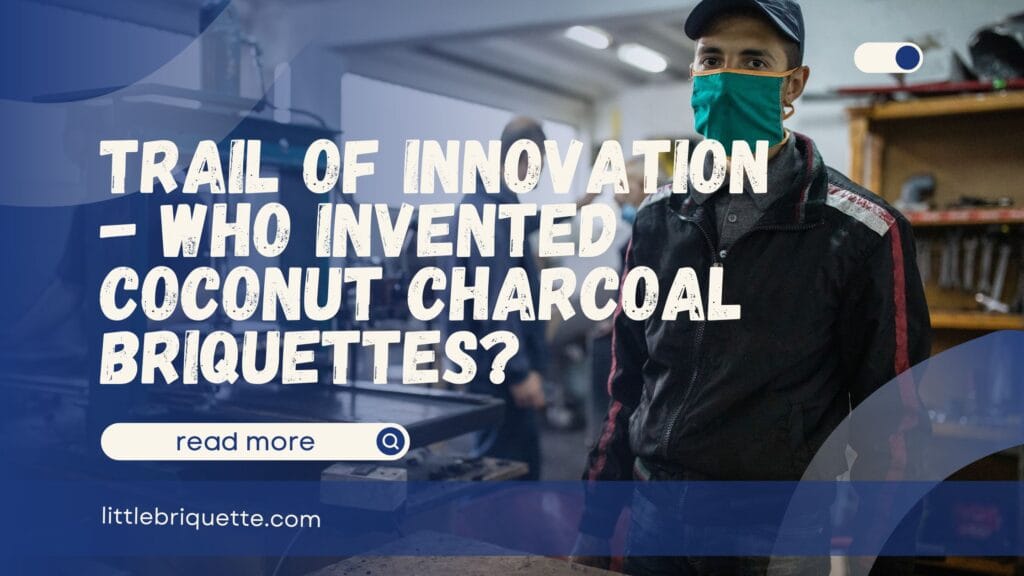Amid the growing awareness of sustainability and environmental impact, coconut charcoal briquettes have emerged as an innovative solution that captures the attention of many. Not only are they used in enjoyable barbecue activities, but coconut charcoal briquettes have also become a top choice in the culinary industry. This is due to their eco-friendly and efficient properties. By utilizing coconut waste in the manufacturing process, these briquettes offer a smart and sustainable way to enjoy a wood-like flavor while helping to protect our planet. But do you know who invented coconut charcoal briquettes?
The History of Charcoal Briquettes
The use of charcoal as a source of heat and fuel dates back to prehistoric times, when early humans first discovered how to convert wood into charcoal through incomplete combustion. Charcoal then became a key component in various everyday activities, from cooking to heating rooms. In many cultures, charcoal plays an essential role in traditional cooking methods, particularly in Asia and Africa, where flavorful dishes often rely on cooking techniques that involve fire.
As time progressed, the concept of charcoal briquettes began to emerge as a solution to improve efficiency and ease of use. In the early 20th century, charcoal briquettes started to be mass-produced, especially in Europe and the United States. New technologies allowed for the production of briquettes from a variety of raw materials, including wood dust and agricultural waste.
In certain cultures, such as in Japan and the Philippines, briquettes made from coconut waste became very popular, providing a more environmentally friendly way to meet energy and culinary needs. This transformation reflects how innovation can change traditions while still respecting local values.
Read Also: Are Charcoal Briquettes Toxic? Learn More About Their Benefits!
Who Invented Coconut Charcoal Briquettes?
Coconut charcoal briquettes have emerged as an innovative solution, offering not only efficient energy but also utilizing the abundant waste from the coconut industry. To delve deeper into this product, let’s explore who invented coconut charcoal briquettes are, how the production process works, and the various benefits they offer compared to traditional charcoal.
Introduction Who Invented Coconut Charcoal Briquettes

Coconut charcoal briquettes were first introduced by innovators in coconut-producing countries, with Indonesia and the Philippines as the primary pioneers. One key figure in the development of these briquettes is a local entrepreneur who recognized the potential of often-overlooked coconut waste. With a background in agriculture and product processing, he began exploring ways to transform coconut shells and fibers into high-value, eco-friendly products. Through this innovative approach, coconut charcoal briquettes not only help reduce waste but also provide a cleaner and more efficient fuel solution.
This innovation gained widespread attention alongside the growing awareness of environmental issues. These inventors not only succeeded in creating a product that meets market demands but also opened up opportunities for coconut farmers and local entrepreneurs to increase their incomes. Thus, the invention of coconut charcoal briquettes stands as a symbol of the successful blend of tradition and innovation in addressing modern challenges.
The Production Process of Coconut Charcoal Briquettes

The production of coconut charcoal briquettes begins with the collection of raw materials, specifically coconut shells and fibers. Once collected, these materials are cleaned and dried to remove moisture that could affect the quality of the charcoal. The next step is the pyrolysis process, where the coconut shells are burned in conditions with limited oxygen. This process produces charcoal with a high carbon content while reducing any harmful substances that may be present.
After obtaining the charcoal, it is then ground into a fine powder. This charcoal powder is mixed with natural binding agents, such as starch or flour, to create a dough-like mixture that can be molded. The mixture is then placed into molds to form solid briquettes. Following the molding process, the briquettes are dried to ensure their quality and durability.
This process, which utilizes waste materials, not only produces an efficient product for energy needs but also supports the principles of a circular economy by making use of resources that were previously considered useless.
Benefits of Using Coconut Charcoal Briquettes Compared to Other Briquettes
One of the main advantages of coconut charcoal briquettes is their lower emissions when burned compared to regular charcoal made from wood. Coconut charcoal burns more cleanly, producing less smoke and harmful gases, making it safer for indoor use and cooking. Additionally, the burning time of coconut charcoal briquettes is longer and more stable, allowing users to cook for extended periods without frequently adding fuel.
Beyond efficiency and safety, the use of coconut charcoal offers significant environmental benefits. By utilizing coconut waste, these briquettes help reduce the need for tree harvesting for charcoal production, thereby contributing to forest preservation. Moreover, the production of coconut charcoal briquettes creates economic opportunities for local communities, generating jobs and improving the livelihoods of coconut farmers. With all these advantages, coconut charcoal briquettes are increasingly becoming a favorite choice in the global market, representing a better and more sustainable alternative.
Impact of Coconut Charcoal Briquette Innovation
The innovation of coconut charcoal briquettes significantly contributes to environmental sustainability by making use of waste from the coconut industry, such as shells and fibers, that would typically be discarded. By utilizing these materials, coconut charcoal briquettes reduce the demand for forest resources, thereby mitigating deforestation and preserving natural ecosystems. The production process also results in lower emissions compared to traditional charcoal, making it a more eco-friendly option. The use of coconut charcoal briquettes as a fuel source helps lower carbon footprints, supporting global efforts to combat climate change.
In the food industry, coconut charcoal briquettes are increasingly becoming the go-to choice, especially in tropical countries where coconuts are abundant. Their ability to provide consistent and stable heat makes them ideal for various cooking techniques, including barbecuing and grilling. Additionally, restaurants and food entrepreneurs often choose coconut charcoal briquettes to offer a more authentic and sustainable culinary experience. The positive impact of this innovation extends not only to the environmental sector but also socially and economically, as the production of coconut charcoal briquettes creates jobs and enhances income for coconut farming communities, helping them achieve economic independence and contribute to sustainable local development.
Read Also: How Long Do Charcoal Briquettes Burn? A Grilling Guide
Coconut Charcoal Briquette Production Centers
To achieve delicious cooking results and an efficient cooking experience, it’s essential to choose high-quality coconut charcoal briquettes. You can trust Little Briquette for your purchase, as we use high-quality Sumatra coconut raw materials sourced from our own plantations, along with a meticulous production process. This ensures the creation of pure and high-quality coconut charcoal briquettes. You can place bulk orders by contacting our admin here.

